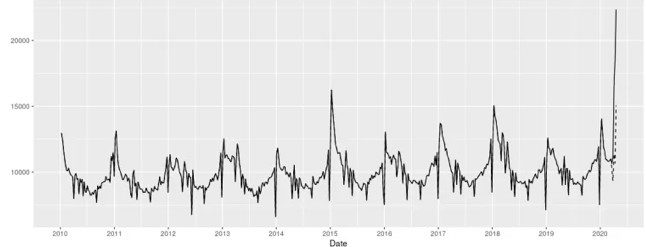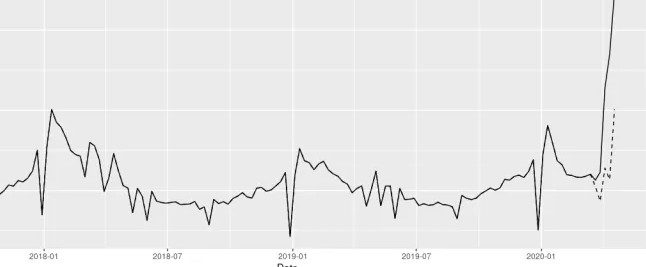
© Getty Images
Here (from the
official source; h/t
Meme Pusher) are the all-cause weekly deaths for England and Wales, 2010 until 17 April 2020.

© UnknownEngland & Wales, Weekly All Deaths, 2010-2020
The dashed line is the same, but
subtracting COVID-19 deaths from the totals. Before we get into this, here is a blow-up of the picture so the end is better seen:

© UnknownEngland & Wales: Weekly All Deaths, 2017-2020
at least, after 2012. Right around Christmas the
all-cause deaths take a regular dip. Before? Nothing. This suggests a reporting and not biological difference. Government workers taking the week off at different rates, or whatever.
This does not surprise us, because we have learned by now how noisy this kind of data is.
Second, the real story is the large spike at the end, which is certainly caused in part by reported coronavirus deaths. We know this because if we subtract these deaths —
-we still see an abhorrent spike, albeit a smaller one.Skip that for a second and concentrate on the large spike.
If the numbers are real, this is an unusual number of deaths, the most in a decade. Again, it's clearly due, in part, to the reported coronavirus deaths.
In other words — stay with me here — given England's
draconian measures, perhaps the most brutal outside of Wuhan or Lombardy,
it appears the lockdown might have killed a lot of people.Maybe cramming the sick and healthy together in confined spaces took its toll. Not just in increased COVID deaths,
but in all kinds of deaths. Such as suicide, unattended strokes and heart attacks and the like, and so on.
The US's numbers aren't complete (as we've seen), but
it's looking like the total body count for the 2017-2018 flu season (I do not say caused by flu, but flu season), from 1 October to 30 April,
is going to matched, more or less, by the 2019-2020 flu season. In other words, the numbers of all-cause deaths in the US looks like
it will play out about the same for these two years for this same period. Now 2017-2018 was by all accounts a bad flu year. This is a bad coronavirus year.
Flu was down this year, but coronavirus (others mutations of which have killed before, in previous years) is way up.
The corpse counts will be about the same. For the US.Not for England. Their dead bodies really stacked up, if accept the official coronavirus death totals.
Taiwan, 6 dead, 24 million people, 0.025 per 100,000, no lockdown.US, 55 thousand dead, 331 million people, 16.7 per 100,000,
martial-law lite lockdown, highly variable across the country.
All of UK, 22 thousand dead, 67 million people, 32.8 per 100,000,
draconian lockdown, more or less enforced. Of course, many more such comparisons can (and will and must) be made.
At a sketch, however,
it appears lockdowns cause more harm than good. The evidence
is consistent with this.
The opposite claim is to say, as must be said in defense of lockdowns, that this unprecedented (modern day) spike would be even larger! Without lockdowns. But then why didn't countries, like Taiwan, which didn't have lockdowns, or only modest ones, have no such glaring spikes?
What else could account for England's huge spike?What else, indeed? Now focus on the blowup. The main spike in undeniable (assuming no errors in counts).
But look at the dashed line, which is also all deaths, but subtracting the unfortunate coronavirus deaths. There is another unexpected spike. We saw in the full decade, secondary peaks of this size didn't happen after flu season. It did happen here. The deaths were not, officials say, coronavirus deaths.
They were therefore other deaths.They must have been unusual deaths, in the sense they occurred with unexpected frequency. Something must have caused them. What else is there but the lockdown? Well, that's not a proof, of course, but the burden of proof is on those who would defend the lockdown.
What are those other deaths? Looking at the breakdowns by age (not shown),
most of the spike in all deaths comes from those north of 60, both male and female, with stronger signals increasing with age, on average. Usually, people this age are dying from cancer and heart disease (strokes, CHF, MIs, and so on). Are these people not seeking medical treatment as usual? People being turned away? Stress, panic, and fear increased? Suicides?
We're assuming the corona deaths are real. Very well, there were 22 thousand of these, as of this date. We have to guess, but supposing there was no coronavirus, we'd expect the data to tale down noisily, as it always has. The extra spike wouldn't be there, by these assumptions. Meaning, with no coronavirus and all its association political and social changes, we'd ordinarily see about 20 + 22 thousand fewer deaths than were observed.
The first 20 thousand is the extra spike. There is, we must admit, considerable uncertainty in that 20 thousand. It isn't 0, and it isn't 50 thousand. It's surely in between, though.
Again, this isn't proof, but it's pretty good evidence the lockdowns caused a lot of harm. Physical harm, at the least.
Naturally, officials, realizing the importance of an analysis like this, might go back,
like our Yale professors, and claim retroactively that the bodies in the secondary spike are all also coronavirus deaths. But that doesn't solve the problem, because then, given the absence of spikes in places without lockdowns, it looks like the lockdowns might be responsible for extra corona deaths.
Reader Comments